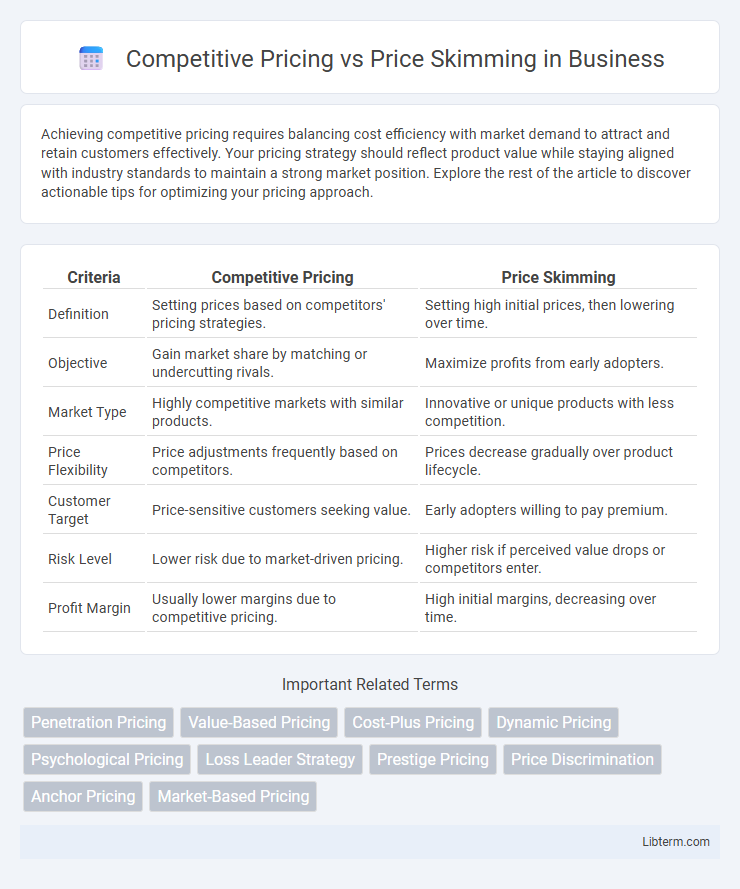Achieving competitive pricing requires balancing cost efficiency with market demand to attract and retain customers effectively. Your pricing strategy should reflect product value while staying aligned with industry standards to maintain a strong market position. Explore the rest of the article to discover actionable tips for optimizing your pricing approach.
Table of Comparison
| Criteria | Competitive Pricing | Price Skimming |
|---|---|---|
| Definition | Setting prices based on competitors' pricing strategies. | Setting high initial prices, then lowering over time. |
| Objective | Gain market share by matching or undercutting rivals. | Maximize profits from early adopters. |
| Market Type | Highly competitive markets with similar products. | Innovative or unique products with less competition. |
| Price Flexibility | Price adjustments frequently based on competitors. | Prices decrease gradually over product lifecycle. |
| Customer Target | Price-sensitive customers seeking value. | Early adopters willing to pay premium. |
| Risk Level | Lower risk due to market-driven pricing. | Higher risk if perceived value drops or competitors enter. |
| Profit Margin | Usually lower margins due to competitive pricing. | High initial margins, decreasing over time. |
Understanding Competitive Pricing
Competitive pricing involves setting product prices based on competitors' pricing strategies to gain market share and attract price-sensitive customers. This approach requires constant market analysis and monitoring competitor moves to ensure prices remain attractive without sacrificing profitability. Businesses using competitive pricing often emphasize value comparison, leveraging cost control and efficiency to maintain competitive advantages.
What is Price Skimming?
Price skimming is a pricing strategy where a company sets a high initial price for a new or innovative product to maximize early profits from customers willing to pay a premium. This approach helps recover development costs quickly before gradually lowering prices to attract more price-sensitive segments. Price skimming is commonly used in technology and luxury goods markets to capitalize on early adopters' demand.
Key Differences Between Competitive Pricing and Price Skimming
Competitive pricing sets product prices based on competitors' rates to attract price-sensitive customers and maintain market share, often used in highly competitive markets. Price skimming involves initially setting high prices to maximize profits from early adopters before gradually lowering prices to reach more price-sensitive segments. The key difference lies in competitive pricing targeting alignment with market rates for volume, whereas price skimming targets maximizing revenue per unit by capturing varying customer willingness to pay over time.
Advantages of Competitive Pricing Strategy
Competitive pricing strategy enables businesses to attract price-sensitive customers by offering products or services at or below market average prices, enhancing market penetration. This approach fosters customer loyalty through perceived value and affordability, thereby increasing sales volume and market share. Moreover, competitive pricing allows quick adaptation to market conditions, making it effective in highly dynamic and price-driven industries.
Benefits of Price Skimming Approach
Price skimming maximizes early revenue by targeting consumers willing to pay premium prices, allowing companies to recoup research and development costs faster. It creates a perception of high quality and exclusivity, enhancing brand prestige. This strategy also provides flexibility for gradual price reductions, capturing different market segments over time.
When to Use Competitive Pricing
Use competitive pricing when entering a market with established competitors offering similar products or services, aiming to attract price-sensitive customers by matching or undercutting rival prices. This strategy is effective in markets with high price transparency and minimal product differentiation, allowing businesses to gain market share quickly. Competitive pricing works best for businesses seeking to maintain steady sales volumes and avoid price wars while positioning themselves as cost-effective options.
Ideal Scenarios for Price Skimming
Price skimming is ideal in markets with innovative products or strong brand loyalty, where companies can initially charge high prices to maximize profits from early adopters. This strategy works well when demand is relatively inelastic and competition is limited, allowing firms to recover research and development costs quickly. Technology products, luxury goods, and unique services often benefit from price skimming during their product launch phase before gradually lowering prices to attract more price-sensitive customers.
Challenges of Competitive Pricing and Price Skimming
Competitive pricing challenges include intense market analysis to match or beat rivals' prices without sacrificing profit margins, risking a price war that can erode industry profitability. Price skimming faces difficulties in accurately gauging consumer willingness to pay at various stages, potentially limiting initial sales volume and attracting competitors to undercut high introductory prices. Both strategies demand careful market segmentation and dynamic adjustments to sustain revenue and market share amid evolving consumer demand and competitive dynamics.
Impact on Market Position and Brand Perception
Competitive pricing establishes a brand as accessible and value-driven, often increasing market share by aligning prices with rivals and attracting price-sensitive consumers. Price skimming sets higher initial prices to target early adopters and maximize profits, which can elevate brand perception through exclusivity and innovation prestige. Market position shifts with competitive pricing favoring volume and broad appeal, whereas price skimming emphasizes premium status and profitability in niche segments.
Choosing the Right Pricing Strategy for Your Business
Competitive pricing involves setting prices based on competitors' benchmarks to attract price-sensitive customers and capture market share quickly. Price skimming targets early adopters with higher prices, maximizing profit margins before gradually lowering prices to appeal to broader segments. Choosing the right pricing strategy depends on your product lifecycle, market demand elasticity, and overall business goals to balance profitability and market penetration effectively.
Competitive Pricing Infographic

 libterm.com
libterm.com